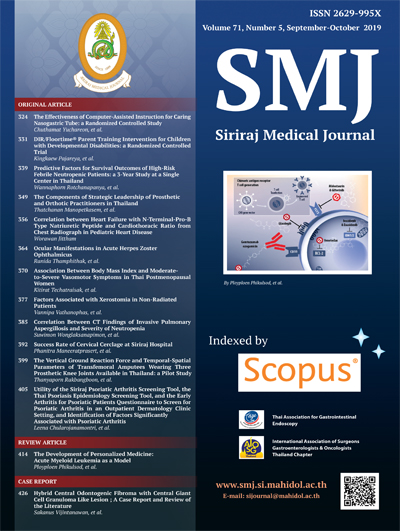The Vertical Ground Reaction Force and Temporal-Spatial Parameters of Transfemoral Amputees Wearing Three Prosthetic Knee Joints Available in Thailand: a Pilot Study
DOI:
https://doi.org/10.33192/Smj.2019.60Keywords:
Prosthetic knee joint; transfemoral amputee gait; vertical ground reaction, temporal-spatial parametersAbstract
Objective: To examine the temporal-spatial characteristics of transfemoral amputees using three prosthetic knees available in Thailand. In addition, the estimated vertical Ground Reaction Force (vGRF) was explored, in particular the graphical differences in the M-shape of the vGRF pattern amongst each of the knees and the sound limb.
Methods: Three transfemoral amputees were fitted with three different prosthetic knee joints (Chulalongkorn University (CU) Polycentric Knee Joint, Prosthesis Foundation Knee, Otto Bock 3R20) and performed walking trials while the vGRF and temporal-spatial parameters were collected for all participants.
Results: Similarities existed amongst GRF metrics across all prosthetic knees. Stance and swing time in the CU Polycentric Knee Joint was similar to that of the sound limb. Walking speeds were highest in the Otto Bock 3R20 and lowest in the Prosthesis Foundation Knee.
Conclusion: This preliminary pilot testing revealed similarities amongst all three prosthetic knees. Future research with more participants and additional analysis could further elucidate characteristics of these prosthetic knees.
Downloads
Published
How to Cite
Issue
Section
License
Authors who publish with this journal agree to the following conditions:
Copyright Transfer
In submitting a manuscript, the authors acknowledge that the work will become the copyrighted property of Siriraj Medical Journal upon publication.
License
Articles are licensed under a Creative Commons Attribution-NonCommercial-NoDerivatives 4.0 International License (CC BY-NC-ND 4.0). This license allows for the sharing of the work for non-commercial purposes with proper attribution to the authors and the journal. However, it does not permit modifications or the creation of derivative works.
Sharing and Access
Authors are encouraged to share their article on their personal or institutional websites and through other non-commercial platforms. Doing so can increase readership and citations.














